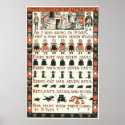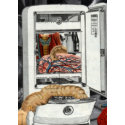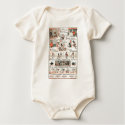Infographic by Foodbeast.
Wednesday, November 27, 2013
The History of Cake
Posted by Deanna Dahlsad
0
comments
Labels:
Food,
Vintage Living
![]()
Monday, November 18, 2013
Cleaning Vintage & Antique Pieces
Posted by Deanna DahlsadUsually, I post vintage tips here from various old publications; but here are some articles I've written recently about how to best clean vintage and antique items today:
* How to clean antique wooden furniture
* How to clean old glass bottles
(Don't worry, scanning will resume shortly!)
Tuesday, November 12, 2013
Tips On Baking With Fats, Liquids, and Clabbering Sweet Milk
Posted by Deanna DahlsadSome tips on baking from Successful Baking For Flavor & Texture by Martha Lee Anderson, copyright 1937, Church & Dwight Company. I find these tips worthy of transcribing from the image text:
Fats. Solid fats can be used interchangeably. Melted fats or oils should not be used in recipes specifying creaming of the shortening.
Liquid. The use of citrus fruit juices, lemon and orange, is the most recent accompaniment with sweet milk and baking soda for leavening. With the health-giving qualities, this new use for fruit juices in baking is widely accepted.
Sweet milk may be used in place of sour milk if clabbered artificially. To sour or clabber sweet milk quickly, place 1 1/2 tablespoonfuls of lemon juice or 1 1/3 tablespoonfuls of vinegar (white vinegar makes a whiter product) in a standard measuring cup, then fill to the one-cup mark with sweet milk. Mix well. The resulting liquid will contain as much acid as natural sour milk or buttermilk when it is at its best for baking and may be used exactly as natural sour milk or buttermilk in any baking soda recipe.
0
comments
Labels:
Cooking,
Recipes
![]()
Thursday, November 7, 2013
Gingerbread House Recipe & Pattern
Posted by Deanna Dahlsad
0
comments
Labels:
Cooking,
Crafty,
Entertainment,
Food,
Recipes,
Traditions
![]()
Tuesday, November 5, 2013
Facts About Disinfecting, Baking Soda & Other Natural Cleansers
Posted by Deanna DahlsadWhile baking soda (bicarbonate of soda) is an excellent and safe household cleaner, there are some things you should know about it -- and other household cleaners.
Baking soda is not officially a disinfectant; it has not been rated as such by the EPA and it is known to generally not be effective against bacteria, including salmonella, E. coli. and staphylococcus. (Neither is vinegar, by the way; though the 5% acetic acid in vinegar does kill some bacteria and viruses, it does not, for example, kill staphylococcus.) However, regular cleaning and good-old-fashioned elbow-grease will address most household cleaning concerns -- including with simple baking soda, vinegar, and basic soap and hot water.
In fact, even when there are flu outbreaks, reasons to fear bacterial infections, persons with weak immune systems in the home, and other reasons to really be concerned, a good scrubbing with simple cleansers and hot water are the place to start. While you do want to remove the dirt and avoid the perfect conditions for bad things to grow in, you don't want to over-strip our world from the good stuff -- the good bacterias which naturally keep the bad bacterias at bay. And even when bad stuff is present, you have to scrub away the dirt to get to the bad stuff itself.
For example, a recent study found that one of the difficulties in disinfecting salmonella was in getting past the biofilms. In the study, rice vinegar just couldn't get past the biofilms (the slimy stuff that forms in wet or humid conditions) to disinfect as well as expected. In other words, scrub that cutting board good and hard using hot soapy water -- and then, if you feel it's warranted, apply the disinfectant. It's similar to how vegetables need to be scrubbed to really remove the pesticides.
You might not want to believe me. But how about believing Professor Peter Collignon?
Collignon is the Director of the Infectious Diseases Unit and Microbiology at the Canberra Hospital, a Professor at the Medical School of the Australian National University, and a member of the World Health Organization's Advisory Group on Integrated Surveillance of Antimicrobial Resistance (AGISAR). Here's what he has to say on the subject in Clean-freak nation:
"The basic good hygiene your mother and grandmother would teach you, washing your hands thoroughly with warm water and soap, is normally enough," [Collignon] says. "But in high-risk situations, alcohol hand rubs are useful and effective. In the kitchen, too, alcohol cleaners are handy, but that doesn't replace good food-handling practices such as proper preparation, refrigeration, no cross-contamination and thorough cooking. And it certainly doesn't mean that if your hands are clean you can eat what you like without a risk of food poisoning. The best thing for killing bugs in food is heating them."
In another interview, Collignon said:
You've got to clean the surface first and that's usually enough. Then you have to ask yourself whether you need to disinfect at all. For the kitchen sink, for example, you probably don't need anything except cleaning. ...We over-use chemicals. Instead of using one unit, we use 1000 units, and the benefits are marginal. All of us would like to use a magic potion so that we don't have to use the elbow grease. But that's a false premise.Yes, over-use of chemicals -- including disinfectants -- is part of the antibiotic-resistant superbug problem
If and when you are concerned by flu, virus, bacteria and other such outbreaks (and you can keep up with them at the outbreaks page at the Centers for Disease Control and Prevention or CDC website), you can then add official disinfectants to your cleaning. Bleach is a good standard; and Seventh Generation makes a line of disinfectant products which uses botanicals to kill over 99.99% of household germs, including Influenza A viruses (such as H1N1, Rhinovirus type 37 aka the Common Cold virus), Staphylococcus aureus, Salmonella enterica, Escherichia coli, and Pseudomonas aeruginosa.
In most cases, scrubbing with baking soda or soap with hot water is enough. If you want to follow that up with some vinegar on cutting boards and counter tops, that's fine; if you have a real reason to worry, follow your scrubbing with a stronger disinfectant. But most of us do not need to do this every time we clean the kitchen or bathroom.
Monday, November 4, 2013
Easy & Inexpensive Snack Sandwiches
Posted by Deanna DahlsadThese recipes are from The Way To His Heart “A Cookbook with a Personality”, copyright 1941, Priscilla Wayne Sprague, published by Western Grocer Company (makers of Jack Sprat Foods). Details on the cookbook and its history is here.
0
comments
Labels:
Cooking,
Recipes
![]()
Sunday, November 3, 2013
Vintage Cleaning With Baking Soda Tips
Posted by Deanna DahlsadIn Successful Baking For Flavor & Texture by Martha Lee Anderson (copyright 1937, Church & Dwight Company), there are many tips for using baking soda for household cleaning. Polishing, cleaning, and sweetening (odor removal), are among the uses. This list of tips is probably no real surprise, as Church & Dwight are makers of baking sodas like Arm & Hammer.
0
comments
Labels:
Household Tips
![]()

























